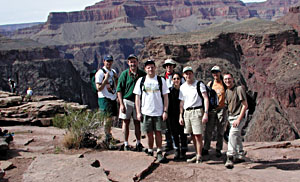 | The idea to investigate the origin of Utah's desert sands was sparked during a departmental field trip in 2002 to Kolob Canyon in Zion National Park led by Professors Reiners and Brandon. The reddish Navajo sandstone, seen in the background, underlies much of the park. Zion is known for cliff-size exposures of ancient sand dunes, where the Navajo sandstone was deposited. |
Team traces Utah desert sand to Appalachian mountains
Using a novel dating technique, Yale geologists discovered that desert sands found in Utah actually originated in the Appalachian Mountains in eastern North America.
"This surprising finding suggests that an ancient westward-flowing river system transported sediment across the continent of North America during the Jurassic era, perhaps in a fashion similar to the Amazon in modern day South America, which carries material across the continent from the Andes," says Peter Reiners, assistant professor in the Department of Geology and Geophysics and co-author of the study published this month in the journal Geology.
During the Jurassic era, approximately 190 million years ago, a huge sand sea similar to today's Sahara desert covered much of the western United States. In southern Utah, these desert sands are exposed at Zion National Park in the Navajo Sandstone, a rock unit famous for its large fossil sand dunes visible in steep cliff exposures.
The tremendous amount of sediment preserved in the sand sea led the researchers to explore the origins of the sedimentary material. The idea for the study arose during a departmental field trip to Zion National Park during spring break 2002 and led by Reiners and Professor Mark Brandon. Zion is known for cliff size exposures of ancient sand dunes, where the Navajo sandstone was deposited. The field trip sparked the idea to use zircon dating to study the source of the Navajo sediment.
Reiners and Jeffrey Rahl, senior author of ,the study and a fifth-year graduate student at Yale, devised a new technique to provide a distinctive "fingerprint" of the original source of most of the sediment found within sedimentary rocks.
The researchers measured both crystallization ages and cooling ages in single sand grains composed of the mineral zircon. The crystallization age corresponds to the time a rock formed deep in the Earth, while the cooling age roughly corresponds to when a rock was eroded at the Earth's surface. Previous approaches have been restricted to the measurement of a single criterion.
"Together, these two ages provide a relatively precise constraint on the source of sediment," Rahl says. "The bulk of the zircons analyzed show a combination of crystallization and cooling ages that is consistent with an origin from only one place in North America: the Appalachian Mountains."
Co-authors included researchers from the Australian National University. The research was partially funded by the National Science Foundation and the Petroleum Research Fund of the American Chemical Society.
-- By Jacqueline Weaver
T H I S
In Focus: Geology and Geophysics W E E K ' S
W E E K ' S S T O R I E S
S T O R I E S![]()
 Yale, unions forge 8-year agreements
Yale, unions forge 8-year agreements![]()
![]()
 Team Lux car to compete internationally
Team Lux car to compete internationally![]()
![]()
 Camp stamp to be dedicated at Cornell game
Camp stamp to be dedicated at Cornell game
![]()
![]()
 Scully honored for shaping he vision of urban planners
Scully honored for shaping he vision of urban planners
![]()
![]()
 Once-misunderstood tree is now a state champ
Once-misunderstood tree is now a state champ
![]()
![]()
 ENDOWED PROFESSORSHIPS
ENDOWED PROFESSORSHIPS Alumnus Robert Post is named the first David Boies Professor
Alumnus Robert Post is named the first David Boies Professor
![]()
 Dan Kahan appointed the Elizabeth Dollard Professor of Law
Dan Kahan appointed the Elizabeth Dollard Professor of Law
![]()
 Stathis Kalyvas comes to Yale as the Arnold Wolfers Professor
Stathis Kalyvas comes to Yale as the Arnold Wolfers Professor![]()
![]()
 Grant supports SOM partnership with non-profits
Grant supports SOM partnership with non-profits![]()
![]()
 Episcopal Church at Yale launches new initiatives with recent gift
Episcopal Church at Yale launches new initiatives with recent gift![]()
![]()
 Events honor theologian Jonathan Edwards' legacy
Events honor theologian Jonathan Edwards' legacy![]()
![]()
 Jazz luminary, virtuoso pianist to play at Sprague
Jazz luminary, virtuoso pianist to play at Sprague![]()
![]()
 Texas native is winner of Yale poetry prize
Texas native is winner of Yale poetry prize![]()
![]()
 Celebration will feature winners of prestigious Italian literary award
Celebration will feature winners of prestigious Italian literary award![]()
![]()
 In Focus: Geology and Geophysics
In Focus: Geology and Geophysics Renovated facilities
Renovated facilities
![]()
 Strengthened faculty
Strengthened faculty![]()
 Team traces Utah desert sand to Appalachian mountains
Team traces Utah desert sand to Appalachian mountains![]()
 Yale geologist leading international study of Italian mountain range
Yale geologist leading international study of Italian mountain range![]()
 New theory explains mystery of Earth mantle's mixed-up composition
New theory explains mystery of Earth mantle's mixed-up composition![]()
![]()
 Fall workshop series will focus on gallery's collections and treasures
Fall workshop series will focus on gallery's collections and treasures![]()
![]()
 Symposium honors the contributions of late sociologist Roger Gould
Symposium honors the contributions of late sociologist Roger Gould![]()
![]()
 Symposium will showcase the research of graduate students . . .
Symposium will showcase the research of graduate students . . .![]()
![]()
 Open house
Open house![]()
![]()
 Volunteer helps others 'feel at home'
Volunteer helps others 'feel at home'![]()
![]()
 Campus Notes
Campus Notes![]()
Bulletin Home |
| Visiting on Campus
Visiting on Campus |
| Calendar of Events
Calendar of Events |
| In the News
In the News![]()
Bulletin Board |
| Classified Ads
Classified Ads |
| Search Archives
Search Archives |
| Deadlines
Deadlines![]()
Bulletin Staff |
| Public Affairs
Public Affairs |
| News Releases
News Releases |
| E-Mail Us
E-Mail Us |
| Yale Home
Yale Home